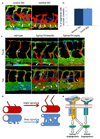Distinct signalling pathways regulate sprouting angiogenesis from the dorsal aorta and the axial vein
- PMID: 21572418
- PMCID: PMC3107371
- DOI: 10.1038/ncb2232
Distinct signalling pathways regulate sprouting angiogenesis from the dorsal aorta and the axial vein
Abstract
Angiogenesis, the formation of new blood vessels from pre-existing vessels, is critical to most physiological processes and many pathological conditions. During zebrafish development, angiogenesis expands the axial vessels into a complex vascular network that is necessary for efficient oxygen delivery. Although the dorsal aorta and the axial vein are spatially juxtaposed, the initial angiogenic sprouts from these vessels extend in opposite directions, indicating that distinct cues may regulate angiogenesis of the axial vessels. We found that angiogenic sprouts from the dorsal aorta are dependent on vascular endothelial growth factor A (Vegf-A) signalling, and do not respond to bone morphogenetic protein (Bmp) signals. In contrast, sprouts from the axial vein are regulated by Bmp signalling independently of Vegf-A signals, indicating that Bmp is a vein-specific angiogenic cue during early vascular development. Our results support a paradigm whereby different signals regulate distinct programmes of sprouting angiogenesis from the axial vein and dorsal aorta, and indicate that signalling heterogeneity contributes to the complexity of vascular networks.
Figures





References
Publication types
MeSH terms
Grants and funding
LinkOut - more resources
Full Text Sources
Molecular Biology Databases

